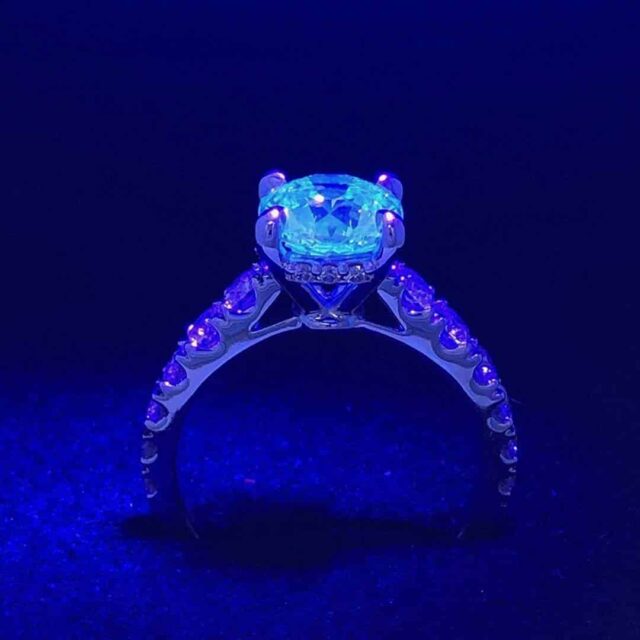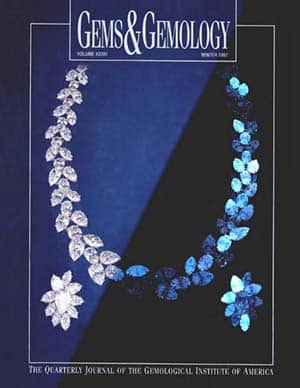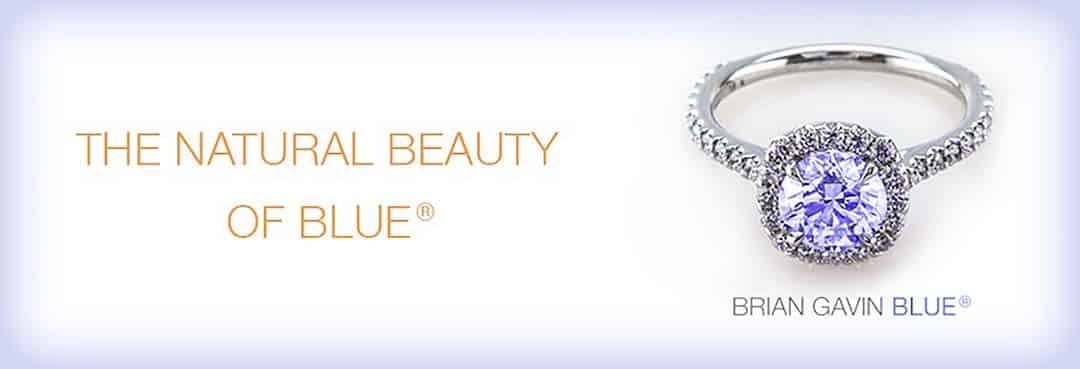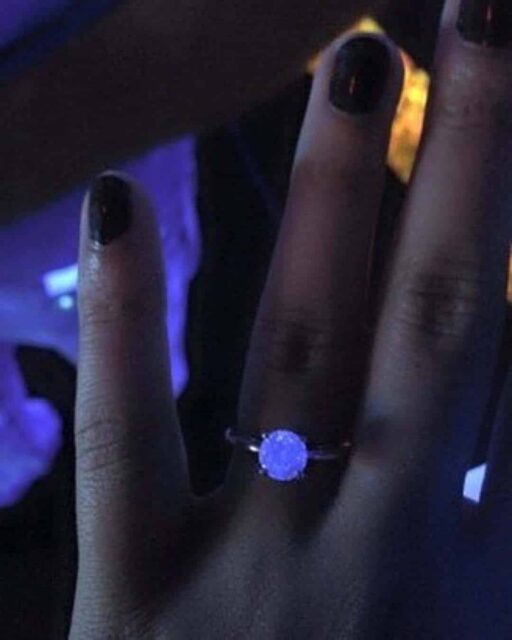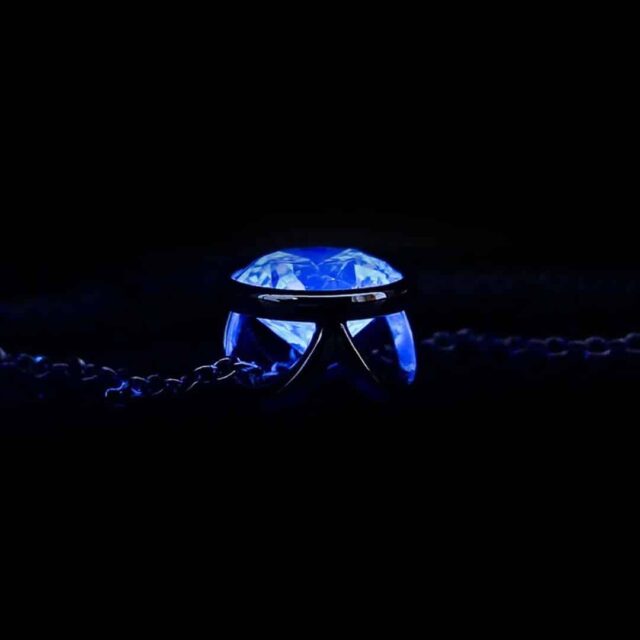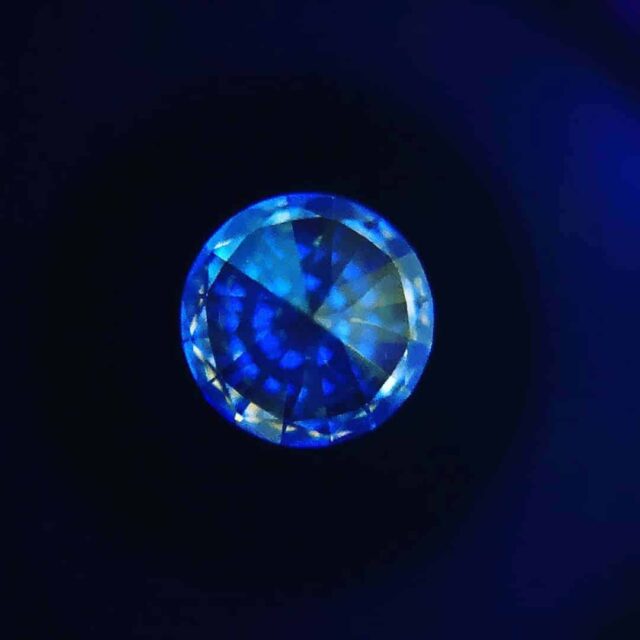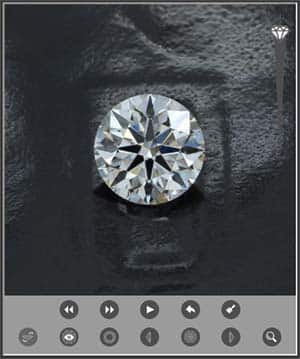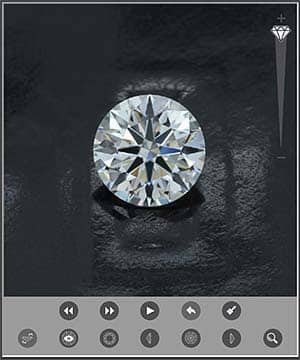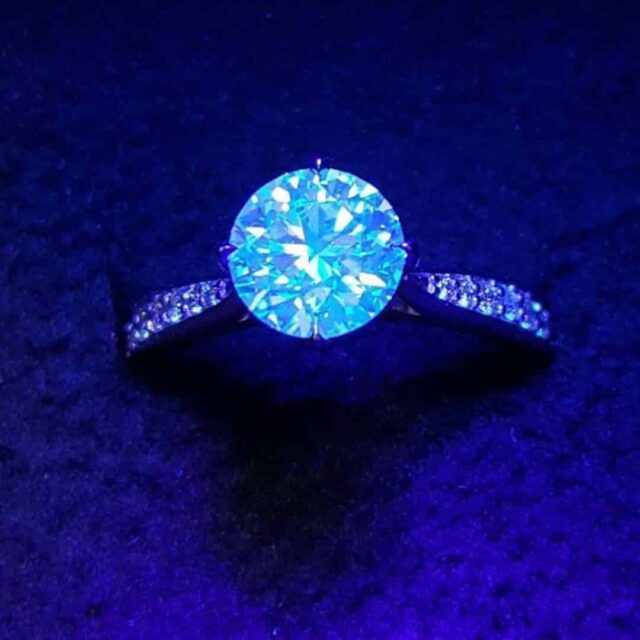Diamond fluorescence is probably the most misunderstood characteristic of gem quality diamonds. For example, many people think that fluorescence will make diamonds look dull or cloudy. However, medium to strong blue fluorescence is more likely to improve your perception of color.
That is because the blue fluorescent molecules serve to filter out yellow undertones. By the way, it is possible for diamonds of all color grades to exhibit yellow undertones. That's right, even D-color "colorless" diamonds are likely to exhibit slight traces of yellow under certain lighting conditions.
In which case, the presence of medium to strong blue fluorescence is likely to improve their appearance. Although this may be true, you're bound to run across some articles on the internet that promote the idea that blue fluorescence is bad.
In my experience, this is because whoever wrote the article does not understand the optical effects of fluorescence. We'll get into that momentarily, but for now just look at this blue fluorescent diamond. How cool does this Brian Gavin Blue Fluorescent diamond look under black light?
What Is Diamond Fluorescence and How Is It Caused?
As a matter of fact, approximately 30% of gem quality diamonds exhibit fluorescence when exposed to long-wave ultra-violet light. Although this may be true, the majority of fluorescent diamonds look identical to non-fluorescent diamonds when viewed under normal lighting circumstances.
Clearly, this is the concept that the Gemological Institute of America (GIA) was trying to get across when they selected this necklace containing blue fluorescent diamonds for the cover of Gems & Gemology Magazine.
The cover of the Winter 1997 edition of Gems and Gemology Magazine shows the diamonds within the necklace under normal light on the left. While the right half of the page shows the diamond necklace as seen under black light.
In the first place, the diamonds on the left look perfectly normal. Obviously, this means that the blue fluorescence is not having a negative impact.
As a matter of fact, the blue fluorescence is only apparent when the necklace is exposed to long-wave ultra-violet light. At which point, we're able to see that the diamonds are a mixture of faint to very strong blue (and quite pretty).
Is Diamond Fluorescence Good or Bad?
According to an extensive study by the GIA, blue fluorescence affects less than 2% of gem quality diamonds in a negative manner. To be specific, the high intensity of distinct blue to over-blue has the potential to make diamonds look cloudy under certain lighting situations.
On the flip side of the coin, that means that blue fluorescence is not an issue in 98% of the time. As a matter of fact, I've never seen blue fluorescence create any negative impact in the range of medium to strong blue.
However, I have seen it make diamonds look cloudy or milky in higher concentrations. In other words, blue fluorescence can create a hazy blue effect in the higher levels of distinct to over-blue. Yet, it is of no consequence at levels less than very strong blue. One of the benefits of buying from Brian Gavin is that he makes certain the fluorescence has no negative impact. Learn more in our Brian Gavin Blue Fluorescent Diamonds Review.
Degrees of Diamond Fluorescence:
The degree of fluorescence is stated on diamond grading reports under the color or comments sections. Descriptions of intensity include: none/negligible, faint/slight; medium, strong, distinct, and over-blue.
Generally speaking, you can expect the following relationship between intensity and effect:
As you can see from the list above, the likelihood of blue fluorescence being a problem is extremely small. In fact, you're pretty safe buying a diamond with an intensity anywhere between faint, medium, or strong blue.
For example, the 2.25 carat, I-color, SI-2 clarity, super ideal cut round diamond that Brian Gavin cut for my wedding ring had distinct blue fluorescence. Although there is about a 2% chance that the high intensity of fluorescence might cause the diamond to look cloudy in direct sunlight, the diamond looked perfectly fine.
At the same time, it did exhibit a slight lavender blue hue from the side profile under those lighting conditions. As a matter of fact, I thought that the slight lavender blue hue was quite pretty.
In addition, your Brian Gavin Blue Fluorescent diamond is going to show its true colors when exposed to black light. This photograph was taken by a client who loves the effect of blue fluorescence under those lighting conditions.
Of course, the diamond looked perfectly normal under most lighting environments as is typical of blue fluorescent diamonds.
What Makes Diamonds Look Cloudy?
One of the biggest urban legends about diamond fluorescence is that it makes diamonds look cloudy. As stated previously, the GIA conducted an in-depth study of blue fluorescent diamonds and determined that phenomena occurs in less than 2% of gem quality diamonds.
So, then, what is it that makes diamonds look cloudy or dark? As you might imagine, the answer is not that simple because there can be many causes. However, the most probable reason is the way that the pupils of our eyes contract to protect themselves from being damaged by the bright light.

One of the best ways to judge the sparkle factor of your diamond is to sit under a tree on a bright sunny day. On the condition that there is a slight breeze, the moving leaves will serve to filter the bright sunlight.
That will enable you to enjoy the sparkle factor without your pupils contracting as much as they do in direct sunlight. In which case, you'll be able to see that your diamond is not really turning dark or looking cloudy in sunlight.
Of course, there are other reasons why your diamond might look cloudy. As a matter of fact, certain clarity characteristics like extensive clouds or twinning wisps can have that effect. However, they usually have to be considerable and cover a large portion of the diamond for that to be an issue.
Illuminating Effects of Fluorescence:
Many people buying diamonds online shy away from fluorescent diamonds for fear that they will look cloudy in sunlight. Under those circumstances, the effect of the fluorescence is not something they can determine in an online listing.
At the same time, many people buying from a jewelry store don't even take fluorescence into account. It stands to reason that people don't think about fluorescence under those conditions. After all, if they're not able to see the effects of fluorescence, then it must not be an issue.
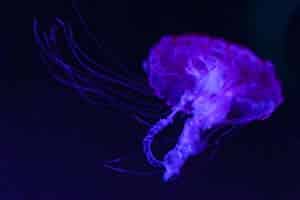
Although this may be true, the reality is that blue fluorescence is a pretty cool phenomena that occurs naturally in many things. Not the least interesting and beautiful of which are jellyfish.
Imagine how cool and exciting it will be to be to see the magic of blue fluorescence in your diamond under black light. As a matter of fact, showing people how diamonds glow blue was a fun part of our in-store presentation.
Something Borrowed, Something Blue:
As a matter of fact, I think that blue fluorescence is a positive trait in white diamonds. As stated previously, the 2.25 carat, I-color diamond that Brian Gavin cut for my wedding ring exhibited distinct blue fluorescence. Obviously, I'm a fan of blue fluorescent diamonds. Then again, I have a good understanding of what different intensities of fluorescence look like.
At the same time, it stands to reason that I'm not going to buy a 2-carat diamond with blue fluorescence if it's going to have any negative impact. With that in mind, it should be perfectly clear that blue fluorescence is a good thing 98% of the time.
Of course, if you want to play it perfectly safe, then you might want to stay in the spectrum of faint, medium, or strong blue. After all, that range of intensity is only going to make the diamond appear whiter and brighter than it will without fluorescence.
The Lavender Blue Hue:
In the first place, it's important to remember that many professionals within the diamond industry choose blue fluorescent diamonds for themselves. After all, it stands to reason that we're not likely to = buy fluorescent diamonds for ourselves if there is a downside.
Now, you might have heard that blue fluorescent diamonds look lavender blue in direct sunlight. As a matter of fact there is some truth to this concept. However, a lot of non-fluorescent diamonds also look lavender-grey in direct sunlight.
Once again, the effect of our eyes adjusting to protect themselves from the brightness of the sparkle will affect our perception of diamond color. At the same time, the exposure to direct sunlight will excite the fluorescent molecules and bring them to life.
Be that as it may, I think that the slight lavender blue hue created by very strong strong to distinct blue fluorescence is quite pretty. At the same time, it is an effect that is so subtle that most people are not likely to notice it without some coaching.
Is Medium Blue Fluorescence Good?
In my experience, medium blue fluorescence is only going to have a positive impact on the appearance of a diamond. That's because the concentration of fluorescent molecules is not intense enough to create any issues.
In other words, medium blue fluorescence is only likely to make your diamond look better. As a matter of fact, I can't think of a single instance where medium blue fluorescence has been bad. By and large, every instance of medium blue fluorescence that I've seen has had a positive impact.
Is Strong Blue Fluorescence Bad?
In my opinion, I think that strong blue fluorescence gets a bad rap because people don't understand it. As a matter of fact, there are a lot of articles online that clearly state that strong blue fluorescence makes diamonds look cloudy. Be that as it may, the vast majority of the people who wrote those articles have no idea what they're talking about.
After all, the GIA Gem Trade Laboratory concluded that fewer than 2% of gem quality diamonds have levels of fluorescence intense enough to detract from the brilliance of the stone. With that in mind, I'd have to say that buying a diamond with strong blue fluorescence is a pretty safe bet.
In the first place, strong blue fluorescence is more likely to enhance the appearance of a diamond by making it seem whiter and brighter. At the same time, it's important to realize that fluorescence is a factor that must be evaluated individually on a stone-by-stone basis.
With that in mind, I highly recommend the Brian Gavin Blue Fluorescent diamonds because Brian personally evaluates every diamond chosen for that collection. That means that Brian has taken the time to physically inspect his diamonds.
In that case, he's able to verify that the fluorescence is only having a positive effect. In contract, the majority of diamond dealers online have never seen the diamonds listed in their virtual inventory.
Causes of Diamond Fluorescence:
Approximately one third of gem quality diamonds are luminescent and luminesce when exposed to UV light. In most cases, the luminescence will stop when the UV light source is removed. This phenomenon is known as fluorescence and it is generally a positive influence on the way a diamond looks.
As a matter of fact, diamonds fluoresce in both long and short wave UV light. However, they tend to fluoresce more intensely when subjected to long wave UV light.
The photograph to the left shows a Brian Gavin Blue Fluorescent diamond under those lighting conditions. Consequently, I happen to think that the blue fluorescence creates a pretty cool effect. Especially as seen here through the pavilion (lower half) of the diamond.
Although this may be true, fluorescence is simply the result of boron molecules being excited by ultra-violet light. The effect of the energy being transferred to the molecules causes them to fluorescence and produce a variety of different colors.
How Many Diamonds Exhibit Fluorescence?
According to the GIA, approximately 50% of gem-quality diamonds fluoresce enough for it to be seen under special lighting conditions, such as exposure to ultra violet (UV) light.
Fewer than 10% of all gem quality diamonds fluoresce strongly enough to make a noticeable difference between the diamonds color when viewed under incandescent light (low in ultraviolet) and in sunlight or fluorescent light (high in ultraviolet).
Fluorescent Diamond Colors:
As a matter of fact, blue is not the only color exhibited by fluorescent diamonds. The presence of different chemicals and impurities within diamonds can cause them to fluoresce white, blue, green, yellow, and red.
The same concept is used in light sticks, but we think the effect is way cooler in diamonds because it is the result of a naturally occurring phenomenon.
Diamond dealer Brian Gavin is so passionate about blue fluorescent diamonds that he actually highlights a hand selected collection of diamonds with blue fluorescence on his web site which he fondly refers to as Brian Gavin Blue.
The photograph on the left shows a rare lime-green fluorescent diamond. Photograph courtesy of Brian Gavin. As discussed previously, blue fluorescence is a property that can enhance the appearance of white diamonds.
This is especially true of those with warmer body colors, such as in the range of J-K-L through Cape colors. However, varying degrees of blue fluorescence are generally a positive trait for diamonds of all color grades.
Common Colors of Fluorescence:
Generally speaking, you'll find that blue fluorescence is the best option for round diamonds. That's because the color blue serves to filter out some of the yellow undertones that may be present in diamonds of all color grades.
On the other hand, I generally avoid white and yellow fluorescence in white diamonds. That is because it tends to have a negative impact upon the perception of diamond color.
Blue White Diamonds:
I'm sure that by now you realize that blue fluorescent diamonds are nothing new. As a matter of fact, diamond dealers used to call then blue white diamonds in the era of our great-grandparents. At that time, blue white diamonds were considered to be a status symbol.
Of course, from a technically legal perspective, that phrase should only have been used to describe D-E-F color diamonds with strong blue or higher degrees of fluorescence. Rule 28 of the Federal Trade Commission's Trade Practice Rules for the Jewelry Industry addresses this issue.
FTC Rule 28 - Misuse of the term Blue White:
"It is an unfair trade practice to use the term 'blue-white' or any other term, expression, or representation of similar import, as descriptive of any diamond which under normal, north daylight or its equivalent, shows any color or any trace of any color other than blue or bluish."
In other words, only a diamond with blue fluorescence can be represented as blue-white. However, smart jewelers have banned the term from their working vocabularies because it's just asking for trouble.
How Much Fluorescence Should A Diamond Have?
I'm sure that by now you realize that any degree of fluorescence within the range of negligible to strong blue is fine. As a matter of fact, most people will not be able to see the difference between a diamond with negligible and strong blue fluorescence under normal lighting conditions.
Take a look at the two Brian Gavin Signature diamonds below and see whether you can tell the difference.
Negligible Fluorescence:
$9,593.00 Cash/Wire.
Suffice to say that both of these super ideal cut diamonds exhibit exceptional sparkle factor. As a matter of fact, the only discernible difference between them is the fluorescence. However, that is not a characteristic that is readily visible without black light.
Be that as it may, the difference in price due to the fluorescence is enough to buy a setting. As a matter of fact, there is a discount applied to blue fluorescent diamonds. Interestingly enough, it has nothing to do with the visual effects of fluorescence.
Fluorescent Diamond Prices:
As can be seen by the example above, there generally is a discount applied to diamonds with fluorescence. Unfortunately, the practice of discounting fluorescent diamonds implies that they are less desirable than non-fluorescent diamonds. Although this may be true, the reality is that nothing could be farther from the truth.
In the first place, the odds are that medium to strong blue fluorescence is going to improve your perception of diamond color. In other words, it is likely to make the diamond appear to be whiter and brighter.
At the same time, this does not mean that an H-color diamond with strong blue fluorescence is going to look like a G-color. As a matter of fact, rumors to that affect have been largely exaggerated. It would be more accurate to suggest that a G-color diamond with strong blue fluorescence will face-up at the high side of that color grade.
Although that might be true, setting a G-color diamond in white metal prongs will also make it look brighter and whiter. With that in mind, it's fair to say that a G-color diamond might look more like F-color under those conditions.
Historical Influences on Price:
Going back a few decades in time will enable us to better understand the reasons why blue fluorescent diamonds are discounted. The fact of the matter is that it has everything to do with marketing and nothing to do with reality.
To begin with the current attitude towards blue fluorescent diamonds originates in the early 1980s. That's when "investment diamonds" were all the rage and speculators were trying to cash-in on the diamond market. As you can imagine, the competition between investment firms was pretty fierce.
At one point, an investment firm in Asia made the announcement that their parcels of investment diamonds did not contain fluorescent diamonds. Keep in mind that up until that point, blue white diamonds were heavily sought after by our grandparents.
Spinning the Urban Legend for Profit:
In the beginning, the marketing efforts of the investment firm did not have much effect. However, all of that changed the moment the chief investment strategist got on Korean television. Imagine the fallout of going on the Korean equivalent of 20/20 and saying that blue fluorescent diamonds are bad.
Needless to say, the fallout was epic. As a matter of fact, it didn't take the urban legend to go viral. Believe it or not, the legend eventually morphed into hysteria based on the belief that fluorescence is the trapped spirits of our ancestors. Consequently, things got so bad in Korea that De Beers stepped in and offered a diamond exchange program.
Although this might be difficult to accept, this is how things were before the invention of Snopes and the internet. Imagine being able to step onto television somewhere in Asia and ignite a blue fluorescent fire around the world. Obviously, it would be much easier to spark that fire today, but it would also be easier to put it out.
Suffice to say that the discount for fluorescent diamonds is the result of diamond dealers discounting the goods in an attempt to regain market share. The fact of the matter is that people practically stopped buying blue fluorescent diamonds in the 1980s as a result of that broadcast. And that's when the real chaos began because people had to come up with their own reasons why blue fluorescent diamonds are discounted.
Should You Buy a Fluorescent Diamond?
In the final analysis, it seems to me that medium to blue fluorescent diamonds represent a great bargain. In the first place, blue fluorescence is likely to make your diamond seem whiter and brighter. Secondly, the discount applied to blue fluorescent diamonds enables you to save some money.
At the same time, I understand why you might be hesitant to buy a blue fluorescent diamond. After all, there are all those horror stories and misinformation to be found all over the internet.
In any event, you might wonder why so many professionals within the trade buy fluorescent diamonds for themselves. The obvious and most likely conclusion is that the majority of rumors about blue fluorescent diamonds are false.
Of course, you can play it totally safe and buy a diamond with negligible fluorescence. On the other hand, you can buy a Brian Gavin Blue Fluorescent diamond with confidence.
That's because Brian Gavin personally evaluates every diamond to ensure that the fluorescence is not having a negative impact.

